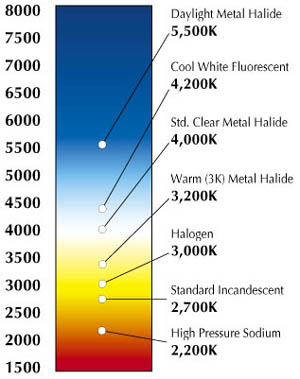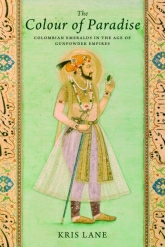
Color temperatures a various types of lighting. 5500-6500 is the Kelvin temperature of daylight. GIA uses a 6200 Kelvin light source for diamond grading.
by Richard W. Wise, ©2011
New Technologies May Require Changes is How We Look At Gems:
In 2007 amid little fanfare, Congress passed a law that required that the efficiency of that iconic household standby, the incandescent light bulb, be improved or perhaps accept its doom. The bulb has been around a long time and the technology has remained virtually unchanged since it was invented by Thomas Edison in 1881. Turns out the old bulb is a real energy waster, only 10% of the energy used is given off as light, the rest is dissipated as heat. Though some called it the death of the incandescent light bulb, Congress merely dictated an increase in efficiency, 20% by 2014, 60% by 2020.
Though the efficiency standards do not state what is allowed, such a dramatic increase in efficiency is bound to require new technologies which are likely to mean changes in the light spectrum produced by whatever technology replaces the old standard. No one has given much thought to the consequences this will have in the gem trade. The new standards are scheduled to take effect this January.
In the evaluation of quality, gemstones have been traditionally viewed under two light sources, noon daylight or more lately daylight equivalent fluorescent lighting and plain old incandescent (in the 19th Century it was candlelight). A stone that looked good by day but muddied up under the lightbulb is taken to be inferior to one that holds its color in both lighting environments. In 2003 I published a book, Secrets Of The Gem Trade, that divides gems into daystones and nightstones. The terms refer to gem varieties that look best under a given source. This seemingly bright idea may mean dramatic reductions in oil imports, but wait! What about the gem business, what’s a connoisseur to do?
The Tea Party To the Rescue:
Well our worries may be over, just last week the House passed legislation to deny funding to the law. Apparently the bill’s original Republican sponsor, Texas Representative Michael C. Burgess had an epiphany. He has seen the, ah, light. “The government has no right to tell me or any other citizen what type of bulb to use at home,” no matter how much energy it might save says Mr. Burgess. We have the right to waste all the energy we like in the privacy of our own bedrooms, says so in the scriptures.
But seriously folks! Sooner or later, new, more efficient types of lighting are bound to replace the old standby. Will there be a new standby? Probably not. We are pretty much at the point where the type of lighting used will be dictated by the setting that it is used in. Call it dial a light! At that point will gem grading light be standardized. To some degree it already has. Most laboratories use some artificial version of daylight. The Gemological Institute of America (GIA-GTL) uses a 6200 fluorescent bulb, American Gemological Labs uses a 5500 Kelvin bulb. What is the next step? Stay tuned to GemWise.
Book Review: The Colour of Paradise, The Emerald In The Age of Gunpowder Empires
Kris Lane
The Colour of Paradise, The Emerald In The Age of Gunpowder Empires
280 pages including appendices
ISBN: 978-0-300-16131-1
 The history of the gem trade is a difficult research topic because gemstones are very small objects of great value that have been highly sought after for millenia by rich and powerful people looking for wealth that was portable and easily concealed. The trade itself has been controlled for centuries by minority groups, often oppressed minorities, Jews, Armenians and Indians for whom secrecy was a proven form of self preservation. Kris Lane is a historian, a Professor of History at the College of William and Mary. In The Colour of Paradise, Professor Lane focuses very well honed research skills on the history of the emerald, one of the rarest, most mysterious and highly valued of all gemstones.
The history of the gem trade is a difficult research topic because gemstones are very small objects of great value that have been highly sought after for millenia by rich and powerful people looking for wealth that was portable and easily concealed. The trade itself has been controlled for centuries by minority groups, often oppressed minorities, Jews, Armenians and Indians for whom secrecy was a proven form of self preservation. Kris Lane is a historian, a Professor of History at the College of William and Mary. In The Colour of Paradise, Professor Lane focuses very well honed research skills on the history of the emerald, one of the rarest, most mysterious and highly valued of all gemstones.
The book contains no particularly major revelations. Most historians of the trade are aware that India’s so-called “old mine” emeralds were, in fact, Colombian emeralds imported by the Spanish into India in the Sixteenth and Seventeenth Centuries. Lane’s contribution is to meticulously document both the early history of Spain’s brutal exploitation of Colombia’s indigenous people and its gem wealth. He gives us a well documented overview of early trade routes and uncovers some very interesting and original information concerning 16th Century production; methods and emerald values.
Lane begins with the 16th Century and follows emerald production in Colombia right up to the present, with a good account of politics and production into the 1990s.
All and all this well organized and well written account brings real clarity to a relatively murky area of history. The book also contains detailed appendices estimating early emerald at Muzo, relative values of emerald and diamond in Europe in the 17th Century and an extensive bibliography. The author has uncovered several original accounts that have until now been unrecognized. Highly recommended.

